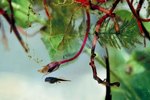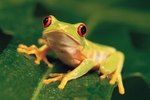
Toads and salamanders are both amphibians, so they have plenty in common. Amphibians fall into three classes: legless, including caecilians; tailed, including salamanders, newts and sirens; and tailless, including frogs and toads. All amphibians are vertebrates, meaning they have backbones -- even the legless caecilians.
Toads and Frogs
It's worth noting that toads are actually frogs, though not all frogs are toads. When people talk about frogs -- the smooth or slimy guys with bulging eyes -- they're thinking about "true frogs," which are members of the Ranidae family. Toads, "true toads," are from the Bufonidae family. These guys are distinguished by dry, warty skin and stubby bodies with short hind legs that lend themselves to walking more than hopping.
A Breath of Fresh Air
One of the most remarkable things about toads and salamanders is the change they experience as they grow from hatchlings into adulthood. When they hatch from eggs, laid in water, they breathe through gills. Eventually they grow lungs and move to land. They also develop legs, allowing them to move on land freely. One difference in development, however, is the tail; as toads develop, they lose their tails.
Soup's On
Neither of these amphibians is choosy about food. They're omnivores, so just about anything is fair game. Salamanders tend to eat insects but will also dine on spiders, worms, crayfish and snails. Toads eat much the same, after eating water vegetation during their tadpole state. Both guys are nocturnal and often feed at night.
Protective Skin
Like all amphibians, toads and salamanders don't bother with showy feathers or hair. Salamanders usually have moist skin, while toads are a bit drier, though exceptions exist. Some species of toads and salamanders use their skin as defense, emitting toxins when they're threatened. Some salamanders sport bright colors as warning to potential predators to beware.
Having Children
As they come from water, they return to water to reproduce. Salamanders fertilize eggs while they're still in the female. Toad females lay eggs and wait for a male to fertilize them. No matter the mechanics involved, both require water to couch the eggs, because they are quite soft. Amphibian eggs don't have shells. They would dry out too quickly to hatch if not laid in water.
References
Photo Credits
-
Jupiterimages/Photos.com/Getty Images



